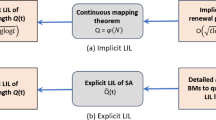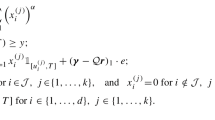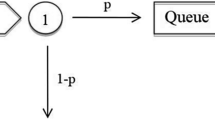Abstract
This paper presents a general algorithmic framework for computing the IPA derivatives of sample performance functions defined on networks of fluid queues. The underlying network-model consists of bi-layered hybrid dynamical systems with continuous-time dynamics at the lower layer and discrete-event dynamics at the upper layer. The linearized system, computed from the sample path via a discrete-event process, yields fairly simple algorithms for the IPA derivatives. As an application-example, the paper discusses loss and workload performance functions in a tandem network with congestion control, subjected to signal delays.






Similar content being viewed by others
Explore related subjects
Discover the latest articles and news from researchers in related subjects, suggested using machine learning.Notes
We adhere to the convention that for a function F:R n→R m, the derivative \(\frac{dF}{dx}\) is an m×n matrix. In the particular case where m = 1, \(\frac{dF}{dx}\) is an n-dimensional row vector.
By Assumption 2(iii), the functions β 1(t) and α 1(θ,t) are continuous at t = z 1,ℓ − 1.
References
Adams R, Wardi Y, Riley G (2007) Sensitivity analysis of loss volume in stochastic fluid systems with flow control. In: Proc 46th IEEE conference on decision and control. New Orleans, Louisiana, pp 1510–1515
Cassandras CG (2006) Stochastic flow systems: modeling and sensitivity analysis. In: Cassandras CG, Lygeros J (ed) Stochastic hybrid systems: recent developments and research trends. CRC, New York, pp 139–167
Cassandras CG, Lafortune S (1999) Introduction to discrete event systems. Kluwer Academic, Boston
Cassandras CG, Pepyne DL, Wardi Y (2001) Optimal control of a class of hybrid systems. IEEE Trans Automat Contr 46:398–415
Cassandras CG, Wardi Y, Melamed B, Sun G, Panayiotou CG (2002) Perturbation analysis for on-line control and optimization of stochastic fluid models. IEEE Trans Automat Contr AC-47:1234–1248
Floyd S, Handley M, Padhye J, Widmer J (2000) Equation-based congestion control for unicast applications. In: Proc ACM SIGCOM, Stockholm
Ho YC, Cao XR (1991) Perturbation analysis of discrete event dynamic systems. Kluwer Academic, Boston
Miyoshi N (1998) Sensitivity estimation of the cell-delay in the leaky bucket traffic filter with stationary gradual input. In: Proc Intl workshop on discrete event systems (WODES’98), Cagliari, Sardinia, pp 190–195
Panayiotou CG, Cassandras CG (2006) Infinitesimal perturbation analysis and optimization for make-to-stock manufacturing systems based on stochastic fluid models. J Discret Event Dyn Syst 16:109–142
Panayiotou C, Cassandras CG, Sun G, Wardi Y (2004) Control of communication networks using infinitesimal perturbation analysis of stochastic fluid models. In: Tarbouriech S, Abdallah CT, Chiasson J (ed) Notes in control and information sciences (LCNCIS): advances in communication control networks. Springer, New York, pp 1–26
Panayiotou CG, Howell W, Fu MC (2005) Online traffic light control through gradient estimation using stochastic fluid models. In: Proc IFAC world congress, Prague
Riley GF (2003) The Georgia Tech Network Simulator. In: Proc ACM SIGCOMM workshop on Models, methods and tools for reproducible network research, pp 5–12
Rubinstein RY, Shapiro A (1993) Discrete event systems: sensitivity analysis and stochastic optimization by the score function method. Wiley, New York
Sun G, Cassandras CG, Panayiotou CG (2004a) Perturbation analysis of multi-class stochastic fluid models. Discret Event Dyn Syst: Theory Appl 14:267–307
Sun G, Cassandras CG, Wardi Y, Panayiotou CG, Riley G (2004b) Perturbation analysis and optimization of stochastic flow networks. IEEE Trans Automat Contr 49:2143–2159
Wardi Y, Riley G (2008) IPA for fluid queue with delayed flow control. In: Proc 47th conference on decision and control. Cancun, 9–11 December 2008
Wardi Y, Adams R, Melamed B (2009) A unified approach to infinitesimal perturbation analysis in stochastic flow models: the single-stage case. IEEE Trans Automat Contr (in press)
Wardi Y, Melamed B, Cassandras CG, Panayiotou CP (2002) On-line IPA gradient estimators in stochastic continuous fluid models. J Optim Theory Appl 115:369–406
Yu H, Cassandras CG (2004) Perturbation analysis of feedback-controlled stochastic flow systems. IEEE Trans Automat Contr 49:1317–1332
Yu H, Cassandras CG (2005) A new paradigm for an on-line management of communication networks with multiplicative feedback control. In: Girard A, Sanso B, Vasquez-Abad F (ed) Performance evaluation and planning methods for the next generation internet. Springer, New York, pp 297–332
Zhao Y, Melamed B (2007) IPA gradients for make-to-stock production-inventory systems with lost sales. IEEE Trans Automat Contr 52:1491–1495
Author information
Authors and Affiliations
Corresponding author
Appendix
Appendix
The purpose of this section is to prove Lemma 1 and Proposition 9.
Proof
[Proof of Lemma 1.] Define Z: = {z i,k,i = 1,2; k = 1,2,...}, namely the set [0,T] ∖ Z consists of the union of the open intervals \(I_{i,k}^o\), i = 1,2; k = 1,2,.... The proof is by induction. Define T min : = min {T 11,T 12,T 21}. Fix t ∈ [0,T] ∖ Z, and suppose that for every τ ∈ [0,t] ∖ Z, \(\frac{\partial\alpha_{i}}{\partial\theta}(\theta,\tau)=0\) and \(\frac{\partial\gamma_{i}}{\partial\theta}(\theta,\tau)=0\), for both i = 1,2. We will show that the same equations hold for all τ ∈ [t,t + T min ] ∖ Z as well, and this will complete the proof.
Consider first the case where i = 1. Fix τ ∈ [t,t + T min ] ∖ Z. If Q 1 was not full at time τ − T 11 and Q 2 was not full at time τ − T 21, then α 1(θ,τ) = σ(τ), and either γ 1(θ,τ) = σ(τ) − β 1(τ) or γ 1(θ,τ) = 0; hence \(\frac{\partial\alpha_{1}}{\partial\theta}(\theta,\tau)=0\) and \(\frac{\partial\gamma_{1}}{\partial\theta}(\theta,\tau)=0\). Next, if Q 1 was not full at time τ − T 11 while Q 2 was full at time τ − T 21, then α 1(θ,τ) = σ(τ) − c 2 γ 2(θ,τ − T 21). But τ − T 21 ≤ t, and hence, and by the above induction’s hypothesis, \(\frac{\partial\alpha_{1}}{\partial\theta}(\theta,\tau)=0\). Moreover, either γ 1(θ,τ) = α 1(θ,τ) − β 1(τ) or γ 1(θ,τ) = 0, and hence we obtain that \(\frac{\partial\gamma_{i}}{\partial\theta}(\theta,\tau)=0\) as well. The other cases, namely where Q 1 was full at time τ − T 11, yield similar arguments, and also the case of i = 2 is provable in a similar fashion. This completes the proof. □
Remark 5
The above proof of Lemma 1 is based on the assumption, made throughout the paper, that T min > 0. If T min = 0 then Lemma 1 still holds true, and it admits a simpler proof. The proof is based on the fact that α i (θ,t) and γ i (θ,t) can be expressed as simple functions of σ(t), β 1(t), and β 2(t), similarly to Lemma 4.1 in Wardi et al. (2009). We do not present the proof here since this paper concerns the case of positive signal delays.
Proof
(Proof of Proposition 9.) We establish the two conditions of Proposition 1. The first condition is satisfied by Assumption 2 and Proposition 2. As for the second condition, it is evident that (w.p.1) the functions J L,i(θ) and J W,i(θ) are piecewise continuously differentiable, and hence, it suffices to prove that there exists a random number K > 0 having a finite first moment such that \(\sup_{\theta\in\Theta}|\frac{dJ_{L,i}}{d\theta}(\theta)|\leq K\), and \(\sup_{\theta\in\Theta}|\frac{dJ_{W,i}}{d\theta}(\theta)|\leq K\).
Since T < ∞ and T ij > 0, there exists a constant K 1 such that the number of induced events at either queue is bounded from above by K 1. By Assumption 2(i) there exists a random number K 2 > 0 such that, the number of boundary periods at either queue is bounded from above by K 2. Finally, by Proposition 7, in conjunction with Propositions 5 and 6, and Eq. 22, it follows that for all θ ∈ Θ, \(|\frac{dJ_{L,i}}{d\theta}(\theta)|\leq 2K_{1}K_{2}\). Similarly, by Proposition 8, \(|\frac{dJ_{W,i}}{d\theta}(\theta)|\leq 2K_{1}K_{2}T\). This completes the proof. □
Rights and permissions
About this article
Cite this article
Wardi, Y., Riley, G.F. Infinitesimal Perturbation Analysis in Networks of Stochastic Flow Models: General Framework and Case Study of Tandem Networks with Flow Control. Discrete Event Dyn Syst 20, 275–305 (2010). https://doi.org/10.1007/s10626-009-0076-5
Received:
Accepted:
Published:
Issue Date:
DOI: https://doi.org/10.1007/s10626-009-0076-5




